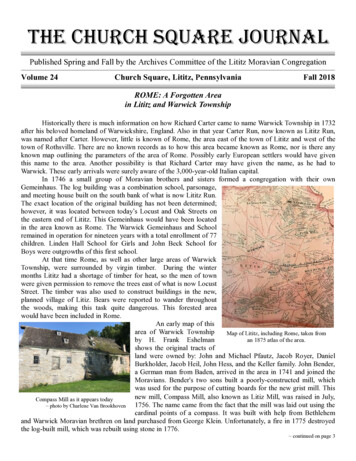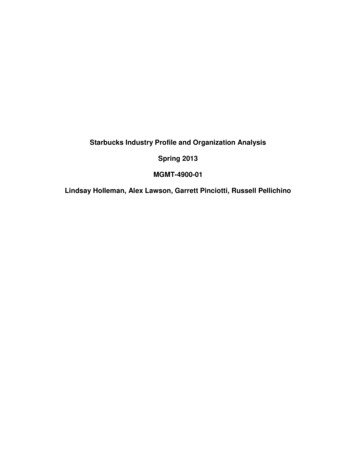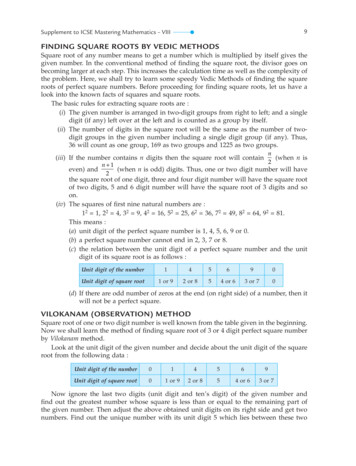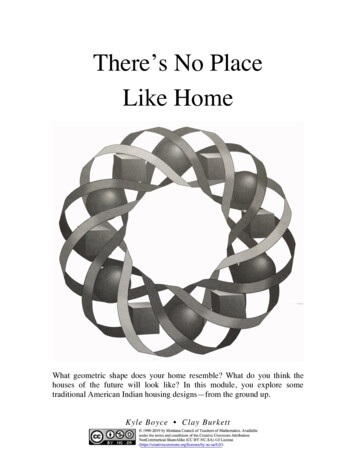
Transcription
THE CHURCH SQUARE JOURNALPublished Spring and Fall by the Archives Committee of the Lititz Moravian CongregationVolume 24Church Square, Lititz, PennsylvaniaFall 2018ROME: A Forgotten Areain Lititz and Warwick TownshipHistorically there is much information on how Richard Carter came to name Warwick Township in 1732after his beloved homeland of Warwickshire, England. Also in that year Carter Run, now known as Lititz Run,was named after Carter. However, little is known of Rome, the area east of the town of Lititz and west of thetown of Rothsville. There are no known records as to how this area became known as Rome, nor is there anyknown map outlining the parameters of the area of Rome. Possibly early European settlers would have giventhis name to the area. Another possibility is that Richard Carter may have given the name, as he had toWarwick. These early arrivals were surely aware of the 3,000-year-old Italian capital.In 1746 a small group of Moravian brothers and sisters formed a congregation with their ownGemeinhaus. The log building was a combination school, parsonage,and meeting house built on the south bank of what is now Lititz Run.The exact location of the original building has not been determined;however, it was located between today’s Locust and Oak Streets onthe eastern end of Lititz. This Gemeinhaus would have been locatedin the area known as Rome. The Warwick Gemeinhaus and Schoolremained in operation for nineteen years with a total enrollment of 77children. Linden Hall School for Girls and John Beck School forBoys were outgrowths of this first school.At that time Rome, as well as other large areas of WarwickTownship, were surrounded by virgin timber. During the wintermonths Lititz had a shortage of timber for heat, so the men of townwere given permission to remove the trees east of what is now LocustStreet. The timber was also used to construct buildings in the new,planned village of Litiz. Bears were reported to wander throughoutthe woods, making this task quite dangerous. This forested areawould have been included in Rome.An early map of thisarea of Warwick TownshipMap of Lititz, including Rome, taken froman 1875 atlas of the area.by H. Frank Eshelmanshows the original tracts ofland were owned by: John and Michael Pfautz, Jacob Royer, DanielBurkholder, Jacob Heil, John Hess, and the Keller family. John Bender,a German man from Baden, arrived in the area in 1741 and joined theMoravians. Bender's two sons built a poorly-constructed mill, whichwas used for the purpose of cutting boards for the new grist mill. Thisnew mill, Compass Mill, also known as Litiz Mill, was raised in July,Compass Mill as it appears today1756. The name came from the fact that the mill was laid out using the photo by Charlene Van Brookhovencardinal points of a compass. It was built with help from Bethlehemand Warwick Moravian brethren on land purchased from George Klein. Unfortunately, a fire in 1775 destroyedthe log-built mill, which was rebuilt using stone in 1776. continued on page 3
Page 2THE CHURCH SQUARE JOURNALFall 2018From the Chair:After almost forty years of talking and planning the archive buildingPublished Spring and Fall byisfinallyenjoying its first summer in air conditioned comfort. We think allThe Archives Committee of Lititzthe bugs and tweaks have been addressed, so we have constant temperatureMoravian Congregationthroughout the building, including the gift shop, all year long. The projectEditor: Marian L. Shattotook several weeks to complete, but with very little interruption to theChurch office: 717-626-8515schedule of events. With help from archive members, we were able to moveOn-line editions can be found atthe displays and artifacts out of the way to allow the work to be completed.lititzmoravian.org/museum—toursThere is some paint touch-up to do over the winter to finish the job. The endresult is a GREAT addition to our museum.Email: ChurchSqJnl@gmail.comWe have had a busy summer hosting tour visitors from all over thecountry and around the world. Archive members have stepped up “big time”to host these tours and promote our Lititz Moravian heritage.There are plenty of activities planned for the coming year, so join us on the second Tuesday of eachmonth for our meeting and learn how you can become a member.The Church Square Journal John Clark, Archives Committee ChairmanBritish Lord Visits Lititz MoravianLord Nathaniel Wei, a member of theBritish Parliament House of Lords, made asurprise stop in Lititz last Spring to visit ourhistoric church square. The Lord Wei, whointroduced himself as ‘Nat,’ was travelingwith his wife, Cynthia, their two young sons,and a local couple. He explained that, as aChristian and the son of a ChristianMissionary, he had a personal interest invisiting Lititz because of its early missionarywork in the colonies.A Lititz Moravian guide led the smallgroup through the church Sanctuary, thecoffee kitchen, and the corpse house. LordWei was particularly inquisitive about thelevels of decision making in the colonialsettlement, and about Moravian interactionswith Native American Indians.His sons were very excited to peekinside the corpse house. After they spent afew minutes inside, the topic of conversationLord Wei, family and friendsturned to zombies as the boys listened tostories of rigor mortis, cooling boards, and photo by Tom Wentzelburial traditions. After taking the time for afew photos and goodbyes, the group journeyed on to its next destination. Thomas Wentzel
Page 3THE CHURCH SQUARE JOURNALFall 2018Continued from page 1:The first people traveling into the area from Philadelphia used the old Peter's Road, an Indian trailestablished by French fur trader Peter Bezillion. This popular trail was heavily used between the SusquehannaRiver and the port of Philadelphia. Near the village of Millport the trail began following Carter Creek to itssource, “the big spring head”. A stop-over resting place was needed because of the duration of these travels. Inthe early 1730s The Rome Hotel was built. The hotel was located on thecorner of Lititz Run and Rothsville Roads. Presumably a copious amountof alcohol distilled nearby and beer brewed locally would have beenconsumed. Sleeping accommodations were crowded with three to fourbeds per room.A short distance east of the Rome Hotel heading north is ClayRoad. This road led from Rome to a trail which would later becomeNewport Road. A bridge was built over Carter Run near the Compass Millto make north-bound traveling less risky. These roads were no more thanEarly photo of the Rome Hotel from theglorified Indian trails.Robert P. “Sketch” Mearig collectionBecause of its location in the area of Rome, the Compass Millmistakenly became known as the Rome Mill. The actual Rome Mill is located on Lititz Run Road and was builtby Johannes Hess in 1769 as a hemp and oil mill. In 1790 the mill began operating as a gristmill. In 1884 theRome Mill was destroyed by fire but was rebuilt on the original stone foundation the next year. Grain wasmilled until 1900. From 1902 until 1910 the Sturgis family of Lititz used the mill as a pretzel bakery. Duringthese years The Rome Distillery stored barrels of whiskey, which was distilled just upstream from the mill. Itwas also used as a tobacco warehouse. Today the Rome Mill, immaculately preserved by the Hess family, sitsalong a beautiful spot on Lititz Run.The first commercial distillery in the area was the RomeDistillery which began production in 1815. The first knownproprietor was Jacob Diehm, a member of the Moravian Church.Locals would take crops such as rye, wheat, and fruit to thedistillery and turn them into fine whiskey. In August of 1893 agroup of prohibitionists set fire to the Rome Distillery, dumping650 barrels of whiskey into the Lititz creek. The alcohol set thecreek on fire, displaying a beautiful blue haze for miles downstream. The distillery continued in operation until the early1920s, when prohibition forced the operation to cease.The 1913 and 1926-27 Lititz Warwick Directories,published by The Express Printing Company in Lititz, both listRome as Route 4 for mail delivery. “Route 4 leaves Lititz via E.Rome Mill as it appears todayFront Street, goes through Rome, follows Lititz Creek to photo by Charlene Van BrookhovenMillport.” In the mid-1930s a Lititz woman took a stroll withher son from what she described as “Rome to Broad Street,” naming every resident along the way. Several yearsago her son shared this recorded information with Lititz historians. The first family name she mentioned wasJonas Eberly. They lived just west of the Rome Hotel. A cluster of houses along Lititz Run Road followingLititz Run is known as Rome. A short street known as Rome Road, between Elm Street and Balmer Road, wasonce an apple orchard owned by Arthur Bruckhart and Sons of Rome.Thus before Lititz was founded, and after Carter arrived and named Warwick Township, the firstMoravian Gemeinhaus was built in the area known as Rome. Unfortunately, Rome lost its official identity whenLitiz became a closed Moravian community. Even though very little has been recorded and written about thiswide-spread area, with no precise map indicating its specific parameters, Rome was and still is a namesynonymous with the industrious people who were instrumental in the founding of Lititz. Charlene Van Brookhoven
Page 4THE CHURCH SQUARE JOURNALFall 2018The Letters of Andreas Albrecht, Jr. to John Gambold, 1793-1794edited by Scott Paul Gordon, Lehigh UniversityAndreas Albrecht, Jr. (1770-1822) wrote three letters to John Gambold (1760-1827) in 1793 and 1794. In the first,dated October 4, 1793, Albrecht described the declining population of Lititz’s single brothers’ house. Men were dying,marrying, or leaving Lititz. The Church Square Journal published this letter in its Fall 2017 issue.In this letter, written eight months later, Albrecht repeats the same news: “our numbers decline.” In 1791, amembership catalog listed 35 adult single men (at least sixteen years old) who lived in the single brothers’ house. In 1794Albrecht can only name 15 adult single men who lived in the single brothers’ house. No wonder it seemed so “empty andquiet.” Many of these men, as note 7 below documents, would marry or leave Lititz over the next decade. But other singlemen joined the choir, and an 1802 membership catalog identifies 20 adult single men in the house.Albrecht also used this letter to describe the many building projects in Lititz. I have tried to correlate the facts thatAlbrecht provides here with information available elsewhere, including Hiram Eberly’s scrapbook about early life inLititz et-lititz/) and a marvelous 1988 three-fold flyer produced by theLititz Historical Foundation. In some cases, this has been difficult because of incomplete, or contradictory, information.In his third letter, which will be printed in a subsequent issue of The Church Square Journal, Albrecht focuses ona new trade and tries to enlist Gambold’s help in that endeavor.This letter has been translated by Edward Quinter, who has worked extensively with Kurrentschrift (the Germanscript that eighteenth-century Moravians employed) and taught Pennsylvania German at Kutztown University. TheMoravian Archives, Winston-Salem, North Carolina, has generously permitted us to print this transcription.For many years Albrecht’s gravesite was recorded as “unknown.”We now know that he anglicized his name to Andrew Albright andis buried in the Penns section of the old Sunbury Cemetery inSunbury, PA. Many of the stones there are toppled, missing, orunreadable. A recent search could not locate his stone. Thanks goto John Lindermuth, librarian of the Northumberland CountyHistorical Society, for providing the record reproduced above.John Gambold is buried in Morrow Cemetery, Gordon County, Georgia photo by John (Jack) MoonMy dear John!Lititz, 11 June 1794Even though I don’t have any lines from you lying in front of me, to which I could respond, I nonetheless can’t usethat as an excuse not to write.I’m sorry to hear that the news from me and Phillips regarding the events there affected you so much. Even though ithasn’t affected me directly, it seems it has robbed me of the pleasure of hearing from you. I don’t know exactly wherefrom and how I received the news of that place, but not a word of it was spoken here. For Phillips and me we didn’tgive it a thought.1What does concern me though is that I am quite healthy at the moment, thank God. As usual I still conduct schoolhere.2 This past winter I made 3200 lbs. of candles. They didn’t last long, and I seldom had any extra on hand inreserve. Since Easter I’ve been learning how to produce heads on nails with the new machine the nail smith has. I dothis between school terms. It’s a way to make a little extra money.3
THE CHURCH SQUARE JOURNALPage 5Fall 2018I don’t have much news to tell you. This year a lot of construction has happened in our village. Detmer’s barn isalready half under roof. Eichler’s house has been enlarged by half.4 At the Sisters’ House, this week a 60’ long washhouse foundation is ready to be laid up. At Masslich’s place (next to Claus Cölln) there is a roof being put on.5Schropp and Miller are also digging a basement. He’s building a stone one-story house. On the corner next to JacobRicksecker, Andre Kreiter is building a two-story wooden house. All of these are to be completed by year’s end.6 Youcan imagine how our place here is becoming quite attractive.But to a larger degree as the number here [in Lititz] increases, to the same degree our numbers decline in the [SingleBrothers’ Choir] House. You can’t imagine how empty and quiet it is here in the House. I don’t think it would takelong to write down all those who live in the rooms.7 A. Lichtenthäler, S. Grosch, C. Christ, with the boys. In theTailor’s room are I and Phillips and John Becker. In the shoemaker room are M. Tschudy, M. Werner, P. Kreider andJohn Holder.8 With Starck is Greenbury still and my brother Jacob, in the kitchen are John Wholeson and CharlesChitty. An older man who still isn’t a Brother, is our night watchman. His name is Loch. Strohle and Eggert are ourChoir Helpers. There you have the whole catalog of names of our Choir. There are only a few boys. Phillips has 2. P.Kreiter 1. In the nailsmiths 1. and Tschudy has the young Jac. Chitty.9My parents and siblings are in good health and spirits. They send their warmest greetings.10I’ll end for now with greetings and kisses in the Spirit many times over, and remain your well-known and affectionateBrother,Andreas Albrecht, Jr.Notes:1John Phillips (b. 1769) would marry in November 1794. It is unclear what “news” Albrecht refers to, though it seemsthat the “news” happened in Salem.2Earlier writers stated that later in his career the gunsmith Andreas Albrecht taught school in Lititz, because of MabelHaller’s note that in 1791 “Brother Andreas Albrecht took over the position” in the Lititz school “vacated by Brother[Francis] Lembke’s transferal to the Paedagogium in Nazareth Hall” (Moravian Education in Pennsylvania [Bethlehem,1953], 100). This letter reveals that it is his son, Andreas Albrecht Jr., who taught school in Lititz.3The single brothers paid for room and board in the single brothers’ house, hence Albrecht’s need for “a little extramoney” and his efforts to pick up various trades: schoolteacher, candlemaker, nailsmith.4Ferdinand Phillip Jacob Dettmers (1718-1801) arrived in Bethlehem in 1761 and later served as a church warden inLititz; Gottlob Eichler (1758-1821), a tobacconist, had married for the second time in 1791; he and Elizabeth Kiehl wouldhave four children.5The home of Claus Coelln (1724-1806), a master carpenter who arrived in Lititz in 1756 to build the brothers’ house,the sisters’ house, and the Gemeinhaus, was on the south side of Main Street, just west of the community store. PerhapsGottlieb Masslich (1752-1811) was the next house to the west, at the corner of what is now Cedar Street.6Christian Schropp (1756-1826) worked as a school master and a nailsmith in Lititz; he had married Anna MariaRussmeyer in 1793 and seems to have built his home, which still stands at 145 Main Street, in the same year. Mostpublished material suggests that Johannes Mueller (“Miller”) built his home (139 Main Street, now owned by the LititzHistorical Foundation) in 1792, but this letter suggests that he was building his “stone one-story house” in 1794. I havenot located the homes of Jacob Ricksecker (1746-1806) or Christian Andreas Kreiter (1751-1824).7In this paragraph, Albrecht lists only fifteen single men (including himself), nearly all of whom would marry or leaveLititz over the next decade. Ludwig Strohle (1767–1827) remained the leader of Lititz’s single brothers until 1799;Matthew Eggert (1763–1831), who had taught at Nazareth Hall (1786–91), was warden of the Lititz single brothers’ housefrom 1792 to 1802. Adolph Lichtenthäler (1769-1834), a carpenter, married in 1795; Samuel Grosch (1768–1850), laterLititz’s shopkeeper, married in 1798, as did Matthias Tschudy (1771-1852), a weaver. Matthew Werner (b.1773) seems tohave married in late 1795 or early 1796, Peter Kreiter (1771-1819) in 1797, and Christian Christ (b. 1773) in 1810. JacobAlbrecht (b. 1775) left Lititz to become a blue dyer in Ephrata, John Leonhard Becker (b. 1775, the son of Lititz’sshopkeeper) had married by 1799 and would work in Manheim as a soap maker, and Charles Chitty (1772-1836) movedto North Carolina. John Georg Stark (1718-1797) and Greenbury Pettycourt (1748-1835) died as single men in thebrothers’ house; Johannes Holder (b. 1773) was still living there in 1802. I have been unable to discover what happened to
Page 6THE CHURCH SQUARE JOURNALFall 2018John Wohlson (b. 1754) or to identify the nightwatchman, Loch. Albrecht had mentioned in his previous letter of October1793 (Church Square Journal, fall 2017) that the single brothers’ were in search of a nightwatchman.8Various trades, including tailor and shoemaker, took place in rooms in the single brothers’ house. For additionalinformation about living arrangements in Moravian choir houses, see Mary Penry to Meredith Penry, April 27, 1798, inThe Letters of Mary Penry, ed. Scott Paul Gordon (Pennsylvania State University Press, 2018), 121.9These boys were apprenticed to tradesmen, including the tailor (Phillips) and the turner (Kreiter). Jacob Chitty (1784–1850) had joined Tschudy in the weaver’s shop.10Albrecht’s parents were Elizabeth Orth (1739-1830) and Andreas Albrecht (1718-1804), who immigrated toBethlehem in 1750. He worked as a gunstocker and teacher in Bethlehem and Christiansbrunn, and ran Bethlehem’s SunTavern, before he moved to Lititz in 1771. History You Can Hear!Successful Launch of Lititz Moravian Collegium MusicumThe inaugural concert of the Lititz Moravian Collegium Musicum (LMCM), billed as Lancaster County’s newest(yet oldest) chamber orchestra, took place on Sunday, September 9th at 7 p.m. in the Fellowship Hall. Despite poorweather, the hall was filled with an enthusiastic audience. Twenty-five professional musicians met for the first time torehearse at 3 p.m. A new LMCM student musicians program provided an educational opportunity for children and youthto “shadow” the instrumentalists during the rehearsal and to usher during the concert.Pastor Dean Jurgen opened with a brief welcome, and JeffreyGemmell, LMCM Music Director and Conductor, made introductoryannouncements. Special thanks were extended to John and MaryLeeYerger, followed by explanations regarding: audience seating “in theround” with the orchestra inthe middle to increaseengagement; the informalnature of the concert, withcurtailed acknowledgementof applause to encouragebrisk pacing; and fact thatmost of the music, edited byGemmell this summer, isfromourCollegiumCollectionandhasnot beenAfternoon rehearsalperformed in ages. photo by Tom WentzelThe concert beganwith selections played on the 1787 Tannenberg which, although not from theCollegium Collection, fit the instrument well: excerpts from J. S. Bach’sPastorale and Buxtehude’s Fugue in C Major (“Jig”). After the singing of thehymn “What Brought Us Together,” the clarinets performed a duet by JohanFredrik Grenser from his Six Duos pour Deux Clarinettes [LCM Add EChamber 4]. The program continued with J. C. Bach’s Sinfonia in D [LCM32]; selections from Herbst’s Hymns to be Sung at the Pianoforte, performedby soprano and tenor soloists; two movements from J. C. Bechler’s Parthia[LCM 175]; and the complete Sinfonia in A Major [LCM 35] by Carl Stamitz.Soprano Kristin Sims, Leola, PA, andAfter a brief intermission, a “Moment of Sharing” by South CarolinianTenorColin Brown, Kensington, MD,and serpentist Craig Kridel, a guest familiar to our Archives Committee fromsing selections from Johannes Herbst’sprevious visits, demonstrated our historic serpent horn. He also shared anHymns to be Sung at the Pianoforteinteresting story about “the Lititz serpentist—Francis (Frantz) Lewis Lennert—who played with the collegium during the 1830s and 1840s. He was a photo by Wayne B. LeFevresilversmith and watch-maker and, fortunately, just a week ago [Kridel] was
Page 7THE CHURCH SQUARE JOURNALFall 2018able to find a signed coin silver spoon that he made.” Kridel purchased the item and placed it on his music stand duringthe concert as a sentimental connection to the past. He will contribute the spoon to our museum to be displayed alongsidethe serpent.The program resumed with MilitaryDivertimentos [LCM 210] by Louis von Esch,chosen for the distinctive serpent horn part,which were followed by a Mozart flute duet[LCM 111]. Another hymn appropriate for theoccasion, “Join We All with One Accord,” wassung, after which excerpts from Boccherini’sCollection of Military Pieces [LCM 200] wereplayed. The final concert piece, AndreasRomberg’s Pater noster [LCM 261], employedthe full resources of LMCM. The concertconcluded with the hymn, “Lamb of God, YouShall Remain Forever,” with verses added thatwere most appropriate for the occasion. Dr. Jeffrey S. Gemmell,Director of Music MinistriesCraig Kridel displays the serpent horn from the Lititz Moravian Archivescollection as he describes this unusual bass horn to the audience. photo by Wayne B. LeFevrePremier Performance of the revived Lititz Moravian Collegium MusicumAudience and orchestra seated “in the round” evoked the intimate setting of anEighteenth Century chamber music concert. photo by Owen Blevins
THE CHURCH SQUARE JOURNALPage 8Fall 2018Antes ‘Cello: Lost and FoundWhile visiting Lititz last September, Provincial Archivist Paul Peucker mentioned to me that they had recentlylearned of the existence of a ‘cello bearing a John Antes label. A few weeks later I received an email from Dave Blum ofthe Moravian Music Foundation (MMF) confirming existence of the ‘cello and asking if I could provide photos of thelabel in the Antes viola in our instrument collection for comparison purposes. Photographing the interior of a stringinstrument requires specialized equipment, but I did the best I could by shooting through one F-hole while a friend shonea flashlight through the other to highlight the faded label.Paul had hoped that the current owner of the instrument might be persuaded to donate it, if authenticated, to oneof the museums. That was not to be. A day after I sent the viola photos to Dave, we learned that the ‘cello was now in thehands of Pook & Pook, Inc., a noted antiques and fine arts auction house located in Downington, PA. There it would beoffered for sale at some time in the coming months.The Christmas holidays came and went. By mid-January we knew that the ‘cello was to be included in an auctionof International and Early Americana antiques scheduled for the last Saturday in January. It would be on exhibit at theauction house during the preceding week so that prospective bidders could examine it more closely than was possiblesimply by viewing the multiple photographs posted on line by the auction house. Tom Wentzel and I arranged to drivedown to see it the day before the auction.Violin label - 1759‘Cello label - 1763Viola label - 1764What we found was a beautiful instrument in extremely fragile condition. Years of storage in an attic had done itno good. Most of the major seams had opened, and the neck remained but tenuously attached to the body. A plastic baglying beside it contained the bridge, the tail piece, a mute, and various other parts that had come detached from the ‘cello.To Tom’s practiced eye, however, there seemed to be no damage that could not be put right by a good luthier. And thelabel appeared to me to be clearly from the same hand as the one in our viola. We drove home that day as convinced astwo non-experts could be that this was indeed one of the lost Antes ‘cellos.According to Bethlehem church records, John Antes constructed seven stringed instruments between 1759, whenhe made a violin, and 1764, just before his departure for Germany to pursue ministerial studies. That first violin is in thepossession of the Moravian Historical Society and on display in the Whitefield House Museum in Nazareth, PA. In 1763Antes made a viola and a “bass” (violincello). The next year he completed a string quartet – two violins, a viola, and a‘cello – on commission for the Bethlehem Collegium Musicum.Rufus Greider, a Bethlehem historian writing in 1873, knew of three Antes instruments: a violin, a viola, which helocates at Nazareth, and a ‘cello in Bethlehem, inscribed “Johann Antes, me ficit in Bethlehem, 1764”. My first thoughtwas that it was this ‘cello which had surfaced, nearly 150 years later; but no, the instrument now on display was clearlylabeled 1763. Where had it been, and how had it traveled from one side of the state to the other? One small clue wasvisible inside, a repair label reading “Repaired by Carl Thorbahn Lancaster PA.” More research was necessary.John Frederick Carl Thorbahn (1834-1915) was born in Germany and as a young man immigrated to Canada,becoming prominent in the musical circles of Montreal and various other cities. He came to Lancaster in 1884, where hetaught music in the high school and at Millersville Normal School (now Millersville University) and on occasion directedthe orchestra at the Fulton Opera House. He is also known to have built more than fifty string instruments. In hopes thathis records might have been preserved, I contacted the archives librarian at Millersville U., only to learn that the school isnot the repository of his papers. Through links on a genealogical website I was able to get in touch with two of his greatgranddaughters, who responded cordially but were able to provide very little additional information. Thus we know onlythat the ‘cello was repaired in Lancaster sometime during the last years of the 19th century or the beginning of the 20th.The ‘cello was put up for sale during the morning of January 26. By early afternoon we knew that the underbidder was a representative for the instrument collection of the Metropolitan Museum of Art, a fact that indicated highconfidence in the authenticity of the instrument. The winning bidder was Thomas Riddle, a prominent businessman of theBethlehem area and a direct descendent of John Antes’ uncle. Two hundred and fifty-five years after leaving theworkshop, the ‘cello had returned to the family of its maker.
Page 9THE CHURCH SQUARE JOURNALFall 2018A flurry of emails and phone conversations ensued over the next few days, determining the best way to proceed insecuring an expert appraisal and evaluation. It was decided that a “reunion” of all three Antes instruments was in orderand that, because of the extreme fragility of the violin, the Whitefield House was the best location. Tom Wentzel and Iobtained permission from the Trustees to transport the viola to Nazareth on Tuesday, February 6. Tom Riddle brought the‘cello. Philip J. Kass, a member of the Appraisers Association of America and an internationally recognized expert andauthor on fine stringed instruments and bows, arrived from his home inHavertown, PA, with the equipment needed to complete a thoroughexamination and comparison of the three instruments. Staff members fromthe museum brought the violin from its display case to the table speciallyset up for the day’s procedure. A reporter and a photographer from theAllentown Morning Call completed the assemblage.One of the tools Kass employed was a narrow, flexible wandtipped with a light and miniature camera. This he inserted into an F-holeof each instrument in turn, using it to view details of interior constructionwithout the necessity of opening the backs. We were able to watch theresulting images on the laptop computer to which the camera wasconnected. As he worked, Kass willingly explained the significance ofwhat he was seeing. His conclusions at the end of the process were thatyes, the ‘cello is from the same maker as are the violin and viola, that theyall exhibit clear traits of the Saxon school of German string instrumentbuilding, and that Antes had both experimented with and refined histechnique over the five years’ span between the construction of the violin,when he was just nineteen years of age, and the viola, which was one ofhis final efforts before leaving for Germany.There are still some questions outstanding. Details of the ‘cello’sfinding are skimpy. What we know so far is that it was acquired from acompany hired to clean out old houses, that it came from a home in aPittsburgh suburb, and that it was then stored for some years before thefinder decided to research the label. As for the link to Carl Thorbahn, oneof the granddaughters who responded to my inquiries observed that ifanyone
The Letters of Andreas Albrecht, Jr. to John Gambold, 1793-1794 edited by Scott Paul Gordon, Lehigh University Andreas Albrecht, Jr. (1770-1822) wrote three letters to John Gambold (1760-1827) in 1793 and 1794. In the first, dated October 4, 1793, Albrecht described the declining population of Lititz's single brothers' house. Men were dying,








![BCA160 Macrame [2015] - NDSU](/img/19/bca160.jpg)


